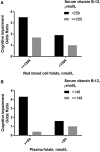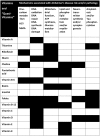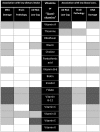Vitamins Associated with Brain Aging, Mild Cognitive Impairment, and Alzheimer Disease: Biomarkers, Epidemiological and Experimental Evidence, Plausible Mechanisms, and Knowledge Gaps
- PMID: 29141977
- PMCID: PMC5682999
- DOI: 10.3945/an.117.015610
Vitamins Associated with Brain Aging, Mild Cognitive Impairment, and Alzheimer Disease: Biomarkers, Epidemiological and Experimental Evidence, Plausible Mechanisms, and Knowledge Gaps
Abstract
The key to preventing brain aging, mild cognitive impairment (MCI), and Alzheimer disease (AD) via vitamin intake is first to understand molecular mechanisms, then to deduce relevant biomarkers, and subsequently to test the level of evidence for the impact of vitamins in the relevant pathways and their modulation of dementia risk. This narrative review infers information on mechanisms from gene and metabolic defects associated with MCI and AD, and assesses the role of vitamins using recent results from animal and human studies. Current evidence suggests that all known vitamins and some "quasi-vitamins" are involved as cofactors or influence ≥1 of the 6 key sets of pathways or pathologies associated with MCI or AD, relating to 1) 1-carbon metabolism, 2) DNA damage and repair, 3) mitochondrial function and glucose metabolism, 4) lipid and phospholipid metabolism and myelination, 5) neurotransmitter synthesis and synaptogenesis, and 6) amyloidosis and Tau protein phosphorylation. The contemporary level of evidence for each of the vitamins varies considerably, but it is notable that B vitamins are involved as cofactors in all of the core pathways or pathologies and, together with vitamins C and E, are consistently associated with a protective role against dementia. Outcomes from recent studies indicate that the efficacy and safety of supplementation with vitamins to prevent MCI and the early stages of AD will most likely depend on 1) which pathways are defective, 2) which vitamins are deficient and could correct the relevant metabolic defects, and 3) the modulating impact of nutrient-nutrient and nutrient-genotype interaction. More focus on a precision nutrition approach is required to realize the full potential of vitamin therapy in preventing dementia and to avoid causing harm.
Keywords: Alzheimer; aging; biomarkers; brain; epidemiology; interventions; knowledge gaps; mechanisms; vitamins.
© 2017 American Society for Nutrition.
Conflict of interest statement
Author disclosures: MF, no conflicts of interest.
Figures





References
-
- Rege SD, Geetha T, Broderick TL, Babu JR. Can diet and physical activity limit Alzheimer’s disease risk? Curr Alzheimer Res 2017;14:76–93. - PubMed
-
- Monti JM, Moulton CJ, Cohen NJ. The role of nutrition on cognition and brain health in ageing: a targeted approach. Nutr Res Rev 2015;28:167–80. - PubMed
-
- Gustafson DR, Clare Morris M, Scarmeas N, Shah RC, Sijben J, Yaffe K, Zhu X. New perspectives on Alzheimer’s disease and nutrition. J Alzheimers Dis 2015;46:1111–27. - PubMed
Publication types
MeSH terms
Substances
LinkOut - more resources
Full Text Sources
Other Literature Sources
Medical

